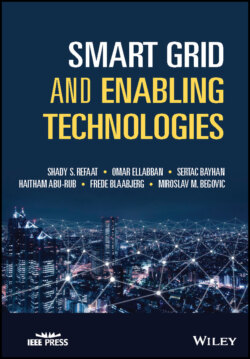Читать книгу Smart Grid and Enabling Technologies - Frede Blaabjerg - Страница 38
1.7.1 Flexibility
ОглавлениеSG distribution, transmission, and generation infrastructures allow for bidirectional power flow and are flexible to accommodate various types of generations, storage, loads, and emerging technologies such as electric vehicles (EVs) and mobile storage. SG allows the integration and operation of generators of all sizes and types at different locations [41]. SG accommodates all renewable energy sources and storage options and flexibly responds to differing humanity expectations and innovations, now and for decades to come. The SG paradigm will also be flexible to customers’ active role regardless of the many existing obstacles.
Figure 1.15 Central operation architecture.
The residential sector is not being targeted by many programs in the traditional grid paradigm as it is hard to deal with due to a multitude of factors such as high acquisition costs and limited access to the individuals. However, currently, new smarter devices can be incorporated with a number of residential appliances to respond locally to the price signals in an automated manner. The flexibility of demand creates values for the grid and customers by minimizing customer bills, shifting consumption to lower prices at off‐peak hours, and reducing demand (during peak periods). Flexibility within demand can also help suppliers in some events to defer investments in central generation, distribution, and transmission.
The SG will be flexible to the customers' active participation. Consumers will utilize the grid in a number ways, more consumers will be “prosumers”: both producers and consumers of energy and to additionally store the energy. The grid will no longer be merely a “delivery pipe” for electric power. All connected to the grid will be masters, no slave and master roles for them in future SGs [42]. The grid can constantly deliver power against disturbances (in extreme climate conditions and periods of natural disasters) without outages over a large area and could maintain information security against various attacks [43].
